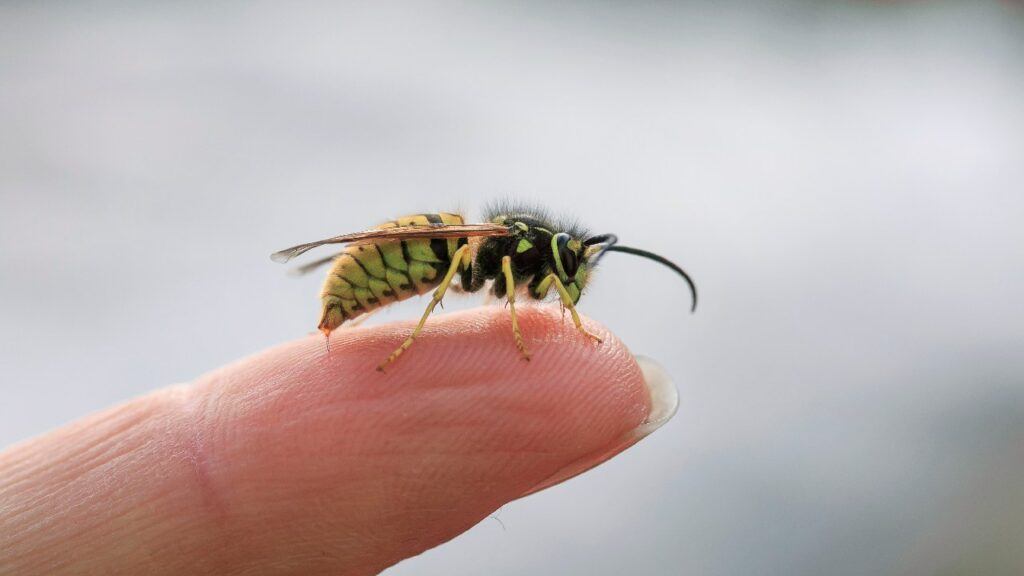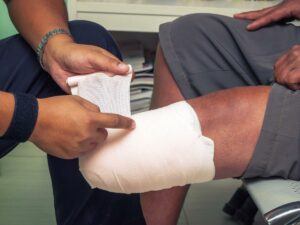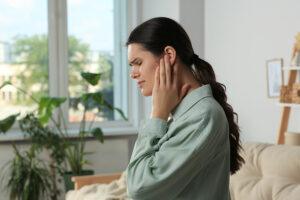The Vital Facts
- Unlike bee stings, which can only sting once, a wasp can sting repeatedly.
- Around one in 10 people who are stung two or more times become allergic, which means they will experience severe reactions to any subsequent stings.
In the warmer months, there is one insect that never fails to strike fear in your heart…a wasp!
Let’s face it, they just look mean. They’re big, brightly coloured, and seem to hover around just looking for a poor family on a camping trip to sting.
While most people have been stung by a wasp before, it doesn’t make their sting any less unpleasant.
So here are immediate first aid steps you can follow to treat wasp stings:
- Wash the affected area
- Apply a cold pack
- Consider an antihistamine or paracetamol
- Keep the affected area clean and dry
- Avoid scratching
See these steps in more detail here.
Read on if you want to learn more about wasp stings and how to provide first aid for wasp stings to make summer a bit less painful!
Here’s a summary of what you’ll find below:
- What happens when a wasp stings you?
- Preventing wasp stings
- First Aid for wasp stings
- Should you go to the hospital?
What Happens When a Wasp Stings You?
Wasps are able to sting you repeatedly without running out of venom or having their stinger break off. This means the exact place where the stinger punctured you may not be very obvious. Unfortunately, this ignorance as bliss won’t last for long…
The stinger injects venom made of peptides and enzymes that break down your cells, some of which are neurons. These neurons send a signal to your brain telling it you are under attack, causing you to feel pain.
The venom also contains norepinephrine, which slows the flow of blood preventing the venom from being diluted. This makes the pain last longer.
Lastly, hyaluronidase and MCDP are two chemicals that allow the venom to move from cell to cell, causing the pain (and swelling!) to spread.
This process is very painful, but it’s also mostly smoke and mirrors. It’s designed to make your body think it’s in imminent danger when in reality the wasp doesn’t pose a serious threat.
Preventing Wasp Stings
While you might think first aid for bees and wasps would be the same (and in many ways they are), preventing stings in the first place is a bit different. When comparing the two species, bees are far more peaceful than wasps.
Where bees usually only react when the hive is damaged or they are touched, wasps are known to sting with far less provocation. So if you do see a wasp, try to avoid it as best you can.
This is especially true towards the end of summer when most insects become more active. Wasps eat insects so summer is the best time to feed. But once they have collected enough food for the colony towards the end of summer, they get bored and travel aimlessly, making them more likely to sting you without cause.
First Aid for Wasp Stings
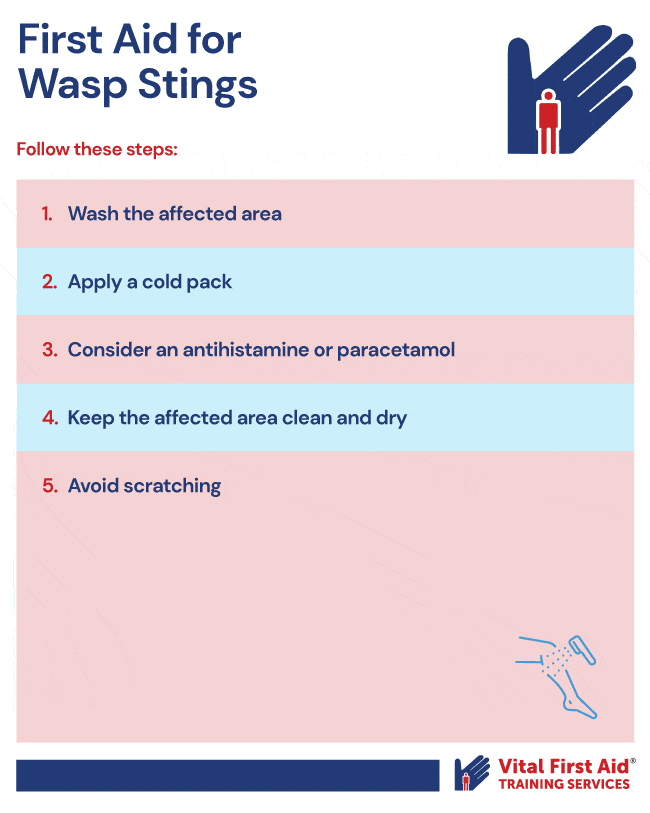
The good news about providing first aid for wasp stings is that you can easily treat them in just 5 steps!
1. Wash the Affected Area
The majority of the venom will be injected into you, but some may leak back out, or be dragged across your skin if the wasp stays on your skin after stinging you. By washing the affected area immediately you can make sure that this leftover venom doesn’t continue to cause pain.
2. Apply a Cold Pack
Both the stinging and swelling sensations can be incredibly painful. Therefore, the main focus of first aid for wasp stings is pain management.
Unfortunately, there is no immediate cure for the pain, but applying a cold pack or compress can help. The cold will also help slow the swelling.
3. Consider Antihistamines or Panadol
Antihistamines can help relieve the swelling and itching of a wasp sting, while panadol is standard first aid for wasp stings due to its pain-relieving effects.
4. Keep the Site of the Sting Clean and Dry
Once the swelling and pain subsides, keep the area clean and dry to prevent any chance of a later infection.
5. Avoid Scratching
After the pain leaves, many people report feeling itchy at the site of the sting. Avoid scratching! All it will do is aggravate the area further and risk creating small abrasions in your skin which could lead to infection.
So there you have it – first aid for a wasp sting. Unfortunately, even with all these steps, you’ll still feel some discomfort. Just remember, the pain is very temporary, and with vigilance, you should be able to avoid wasp stings quite easily.
Should You Go to the Hospital?
First aid for wasp stings usually doesn’t require going to the hospital or calling an ambulance, but there are some rare circumstances where it may be necessary.
Stung Multiple Times
Unlike bees, which die after stinging you, wasps can sting you repeatedly. They also swarm, meaning you can be stung by multiple wasps multiple times if you aren’t careful.
This can be a serious threat to toddlers. Their bodies are smaller so multiple stings can quickly overload them with a lot of venom.
Stung in the Eye or Mouth
Like any penetrating eye injury, you want to make sure you seek out professional help as soon as possible. Later infection is also a risk and needs to be monitored.
Likewise, if you are stung inside the mouth, swelling could block your airways and be a choking hazard. Seek medical attention immediately because this could quickly become life-threatening. This is especially true for a small child.
Anaphylaxis
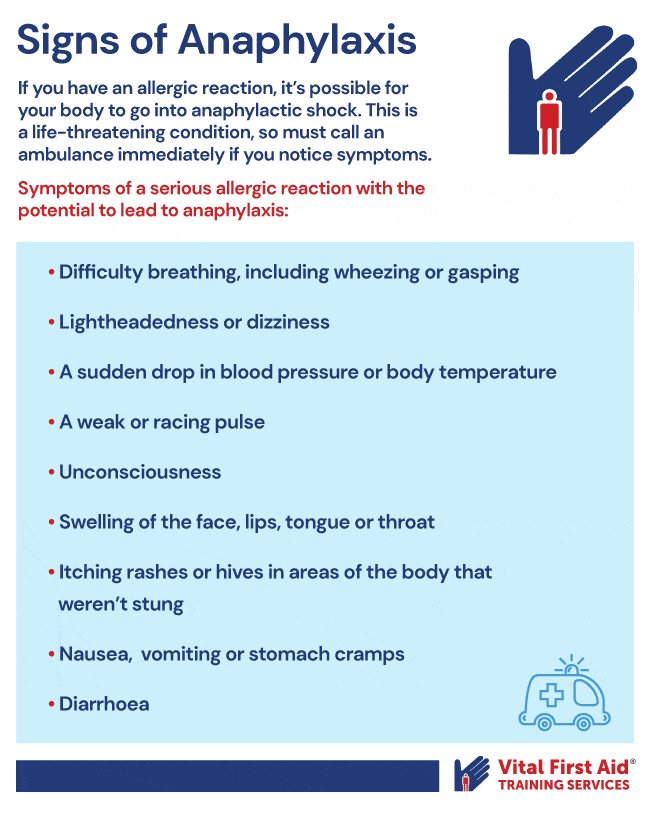
For most people, wasp stings are an unfortunate experience, but for a small percentage, they can be life-threatening.
If you have an allergic reaction, it’s possible for your body to go into anaphylactic shock. Just like a shock response from an injury, it’s essential that an ambulance is called straight away.
Symptoms of a serious allergic reaction to a wasp sting, with the potential to lead to anaphylaxis, are as follows:
- Difficulty breathing, including wheezing or gasping
- Lightheadedness or dizziness
- A sudden drop in blood pressure or body temperature
- A weak or racing pulse
- Unconsciousness
- Swelling of the face, lips, tongue or throat
- Itching rashes or hives in areas of the body that weren’t stung
- Nausea, vomiting or stomach cramps
- Diarrhoea
If you suspect anaphylaxis, you must call an ambulance immediately. If you have an Epinephrine Pen (EpiPen) use it!
Have You Considered a First Aid Course?
Now that you have more confidence in dealing with wasp stings, have you considered developing a more well-rounded first aid knowledge?
Vital First Aid offers realistic training courses for a wide range of other first aid types. Rest assured they’ll teach you to stay calm and composed when faced with stressful first aid situations.

